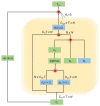A Spatio-Temporal Graph Convolutional Network Model for Internet of Medical Things (IoMT)
- PMID: 36366135
- PMCID: PMC9656165
- DOI: 10.3390/s22218438
A Spatio-Temporal Graph Convolutional Network Model for Internet of Medical Things (IoMT)
Abstract
In order to provide intelligent and efficient healthcare services in the Internet of Medical Things (IoMT), human action recognition (HAR) can play a crucial role. As a result of their stringent requirements, such as high computational complexity and memory efficiency, classical HAR techniques are not applicable to modern and intelligent healthcare services, e.g., IoMT. To address these issues, we present in this paper a novel HAR technique for healthcare services in IoMT. This model, referred to as the spatio-temporal graph convolutional network (STGCN), primarily aims at skeleton-based human-machine interfaces. By independently extracting spatial and temporal features, STGCN significantly reduces information loss. Spatio-temporal information is extracted independently of the exact spatial and temporal point, ensuring the extraction of useful features for HAR. Using only joint data and fewer parameters, we demonstrate that our proposed STGCN achieved 92.2% accuracy on the skeleton dataset. Unlike multi-channel methods, which use a combination of joint and bone data and have a large number of parameters, multi-channel methods use both joint and bone data. As a result, STGCN offers a good balance between accuracy, memory consumption, and processing time, making it suitable for detecting medical conditions.
Keywords: Internet of Medical Things (IoMT); graph convolutional network (GCN); healthcare; human action recognition (HAR).
Conflict of interest statement
The authors declare no conflict of interest.
Figures










References
-
- Papaioannou M., Karageorgou M., Mantas G., Sucasas V., Essop I., Rodriguez J., Lymberopoulos D. A survey on security threats and countermeasures in internet of medical things (IoMT) Trans. Emerg. Telecommun. Technol. 2022;33:e4049. doi: 10.1002/ett.4049. - DOI
-
- Su Y.S., Ding T.J., Chen M.Y. Deep learning methods in internet of medical things for valvular heart disease screening system. IEEE Internet Things J. 2021;8:16921–16932. doi: 10.1109/JIOT.2021.3053420. - DOI
-
- Yang L., Yu K., Yang S.X., Chakraborty C., Lu Y., Guo T. An intelligent trust cloud management method for secure clustering in 5G enabled internet of medical things. IEEE Trans. Ind. Inform. 2021;18:8864–8875. doi: 10.1109/TII.2021.3128954. - DOI
-
- Swarna Priya R.M., Maddikunta P.K.R., Parimala M., Koppu S., Gadekallu T.R., Chowdhary C.L., Alazab M. An effective feature engineering for DNN using hybrid PCA-GWO for intrusion detection in IoMT architecture. Comput. Commun. 2020;160:139–149. doi: 10.1016/j.comcom.2020.05.048. - DOI
MeSH terms
Grants and funding
LinkOut - more resources
Full Text Sources
Research Materials
Miscellaneous

